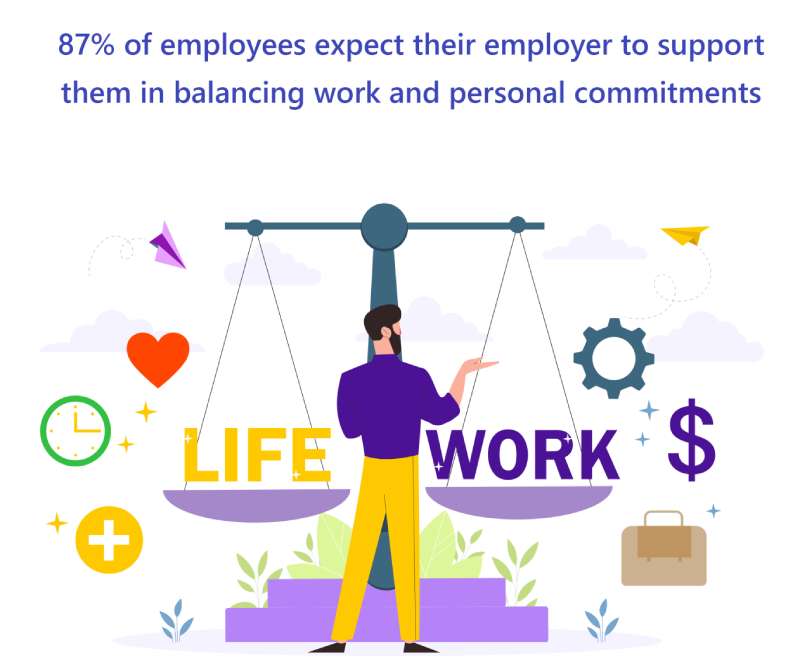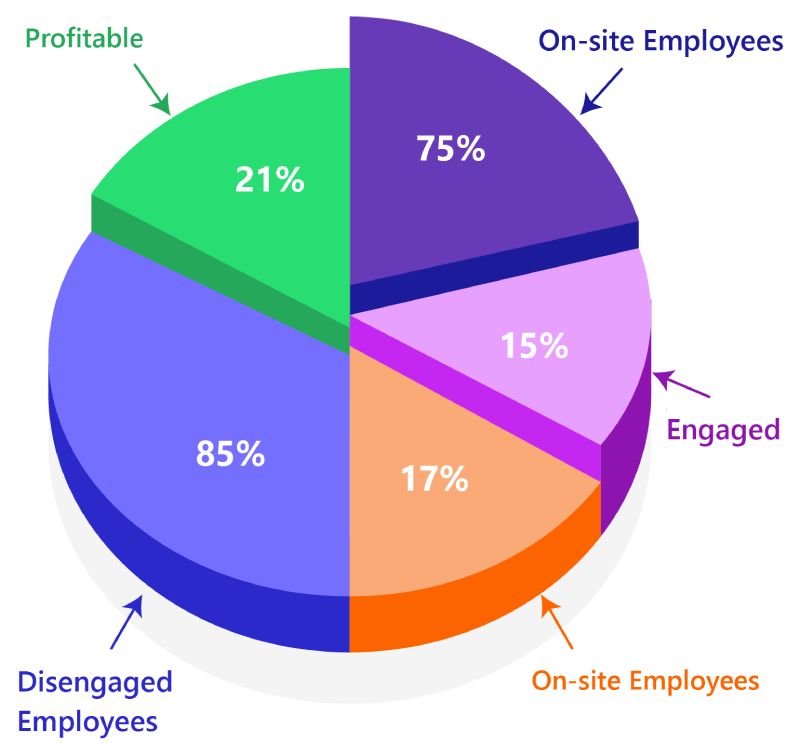Think about going to a workplace where people are full of energy. People look at their peers with warm smiles, people do not hesitate to share their ideas during the meetings, and there is a feeling of unity. This is what it feels like when employee engagement is alive and kicking.
What is Employee Engagement?
But what does it mean to be engaged in the workplace? It is not just about job satisfaction or happiness. Employee Engagement is the extent to which employees are willing to invest themselves in the organization and its objectives. When people are committed, they do not merely act mechanically, they are interested in their job, appreciated, and try to do their utmost. In the current world of business, where competition is high and the rate of change is fast, organizations need to ensure that their employees are engaged.
10 Insightful Employee Engagement Statistics
Here are 10 employee engagement statistics that will help you understand the current situation and the best practices for improving morale, productivity, and organizational culture in the modern world.
87% of Employees Expect their Employer to Support them in Balancing Work and Personal Commitments
- According to a survey conducted by Flex Jobs in 2022, 87% of employees expect their employers to assist them in managing work and personal responsibilities, which shows that employees are now more concerned with flexibility and work-life balance than with monetary rewards and job security.
- Those employers who are willing to adopt such policies will be able to improve the organizational culture and increase productivity, as today’s employees pay much attention to working conditions.
- The COVID-19 pandemic has forced companies around the world to adopt remote work policies, and flexibility has emerged as a key driver of employee engagement and productivity.
- Businesses that do not provide flexible working arrangements are likely to lose out in the battle for talent since such policies have become standard features of an employee package.

76% of Employees Believe that their Well-Being is a Crucial Factor in their Engagement
- The focus is now shifting to wellness programs and mental health services where employers are now spending more money on work-life balance.
- A Gallup survey conducted in 2021 revealed that 76% of workers consider well-being as important for engagement, thus proving that health is now a priority in the workplace.
- It is now being realized that the well-being of the employees is a good investment for happiness, productivity, and retention in modern organizations.
69% of Employees Say they’d Work Harder if they were Better Appreciated
- The Workhuman survey conducted in 2021 revealed that 69% of the employees said that they would work harder if they were recognized more, showing the correlation between recognition and productivity.
- This trend indicates the increasing recognition of the need for non-tangible and psychological factors in addition to tangible rewards, which underlines the importance of a positive organizational climate.
- Companies that incorporate daily, personal appreciation techniques have noted low turnover and high staff performance, which are in line with the modern global business practices of frequent feedback and flexibility.
Organizations with a Strong Culture of Recognition have a 31% Lower Voluntary Turnover Rate
- Companies with a culture of recognition experience a 31% lower turnover rate because appreciated employees are less likely to quit.
- Highly engaged employees are 21% more profitable, proving that proper recognition is financially rewarding for the company.
- A study shows that 89% of the employees in organizations that have integrated wellness and recognition programs have higher job satisfaction, which is why such programs should be encouraged to improve morale and reduce turnover.
- Praise increases employees’ morale and is consistent with modern business practices that focus on the health and productivity of employees for the benefit of the company.
Only 15% of Employees Worldwide are Engaged in their Jobs
- Although the level of engagement of workers in the United States has slightly increased in 2023, the current level of engagement is at a meagre 33%, which shows that the issue of disengagement of the workforce remains a major concern.
- Flexible working conditions could be another factor that can be used to increase employee engagement since 81% of the hybrid employees and 78% of the remote employees reported high engagement compared to 75% of the on-site employees.
- Research shows that organizations with the highest levels of employee engagement are 21% more profitable and 17% more productive, proving that engagement is a key determinant of organizational performance.
- It is important to note that while regular recognition is essential, only 39% of the workforce receives it, which is a significant management issue that could be rectified to improve engagement and fit with the current business model of promoting employee wellness and satisfaction.

Engaged Employees are 87% Less Likely to Leave their Organizations
- Engagement is important in reducing turnover because employees who are engaged are 87% less likely to quit their jobs.
- Engagement leads to a 21% increase in profitability, which is the business case for employee engagement.
- Hybrid workers are more engaged, with 81% stating that they are highly engaged.
- Notably, only 37% of executives consider engagement as a priority area, which indicates a disconnect between acknowledging the importance of engagement and addressing it.
53% of HR Professionals Say Employee Engagement Rises When Onboarding is Improved
- SHRM (2022) revealed that 53% of HR professionals said that the engagement of the employees rises when the onboarding procedures are enhanced, making it a crucial process.
- Effective onboarding enhances the new employees’ first impressions and increases their participation level as opposed to the conventional unstructured methods.
- Modern business strategies are aimed at creating individual approaches to onboarding, technology implementation, and transparent career ladders to increase early employee engagement.
- Improving onboarding practices not only increases levels of engagement but also decreases attrition rates within the first year, which is beneficial for organizational effectiveness.
Disengaged Employees Cost U.S. Companies up to $550 Billion Annually
- Employees who are disengaged at work result in up to $550 billion loss for U. S companies as estimated by The Engagement Institute (2022), which is an important financial loss.
- Disengaged workers cost more than engaged employees because they are less productive, take more sick days, and have a higher turnover rate.
- Current business practices reveal that organizations with high levels of engagement have better financial performance, hence the need for engagement practices.
85% of Employees Reported that Access to Technology that Enhances their Remote Work Experience Significantly Improves their Engagement
- Engagement has increased by 85% due to the enhancement of technology in working from home, proving that technology is key to enhancing engagement.
- Companies that offer reliable tech support experience increase efficiency and employee satisfaction among their teleworkers.
- Modern business approaches focus on the acquisition of advanced collaboration technologies, cloud solutions, and virtual meeting platforms to enhance remote work productivity.
- It is still crucial to focus on the development of high-tech tools to maintain interest in active remote and hybrid work environments.

72% of Employees Who Feel Engaged Report a Higher Level of Productivity
- Employees who are engaged are 26% more productive and have 41% lower levels of absenteeism, which is very costly to organizations.
- Employee engagement has been found to increase profitability by 21% in companies that have it as compared to those that do not.
- Indeed, studies show that for every 1% rise in engagement, there is an increase in revenue of $100,000 per year.
- Thus, by focusing on employee engagement, companies can gain the benefits of higher productivity, profitability, and growth, which will help to lead the company to success.
Why is Employee Engagement Important?
Henry Ford once said, “Coming together is a beginning, staying together is progress, and working together is a success.”
In the current business environment, this statement could not be more accurate. At the core of this philosophy rests a profound realization: the significance of the concept of employee engagement. But what does it mean and why is it important? Now, let’s turn to the concept of employee engagement and find out why it is the key to all the companies’ problems all over the world.
Productivity Boost
Employees who are engaged are more committed and motivated hence the productivity levels will be higher. They are more proactive, accountable for their work, and are willing to work harder to accomplish organizational objectives.
Retention and Talent Acquisition
The employees engaged in their work are not likely to quit their jobs, and this helps improve retention rates and cut down on turnover costs. Also, organizations with high employee engagement levels are more appealing to talented employees, which means that they can easily attract and retain the best talent.
Positive Work Culture
Engagement creates a positive organizational culture where employees trust each other, work together, and communicate effectively. If employees are appreciated and encouraged, they will be satisfied with their job and be productive in the organization.
Innovation and Creativity
Employees who are engaged are more likely to come up with new ideas, participate in problem-solving, and facilitate change within the organization. Engagement culture fosters creativity and innovation since people are willing to try new things and improve on what they are doing.
Customer Satisfaction
Employees who are committed to their work are more likely to provide quality customer services and foster good customer relations. This positively impacts the organization as it increases customer satisfaction and employee loyalty.
Health and Well-being
The engagement of employees is beneficial as it leads to better physical and mental well-being and reduced stress. Moral, healthy, and happy employees are more effective, more efficient, and better placed to deal with any adversity.
How are Employee Engagement and Productivity related?
Employee engagement and productivity are correlated, and engaged employees are likely productive. When employees have a sense of belonging and are driven by purpose, they are more effective in the performance of their duties. They are also more likely to be innovative, satisfied, and happy and are likely to remain with the organization for longer.
- Commitment: Committed employees have a passion for their job and the organization’s objectives.
- Motivation: This is because engaged employees are always motivated to see results and are not likely to do the minimum to achieve goals.
- Innovation: Employees who are committed to their work are likely to be more creative in their work. They are ready to take risks in terms of ideas and processes, which results in enhanced productivity and organizational performance.
Conclusion
In conclusion, employee engagement statistics are useful in analyzing the correlation between engagement and productivity. Creating a positive culture and focusing on engagement activities enables organizations to unlock the hidden potential of their employees, leading to increased productivity, motivation, and overall organizational performance.
Are you prepared to improve your employee engagement with practical solutions?
Know More
Frequently Asked Questions
Some of the factors that influence engagement are communication, training and development, rewards, organizational climate, and leadership.
Engagement is directly proportional to productivity as engaged employees are normally motivated and perform better. This commitment results in lower turnover and enhances organizational performance in many instances. ullamcorper mattis, pulvinar dapibus leo.
The factors that can improve the level of engagement and productivity of the employees are communication and development, appreciation and recognition, organizational culture, work-life balance, and leadership and support.
The ideal employee engagement score is usually between 70% and 90%. However, the ideal score may vary depending on the industry standards and the organizational objectives. Measuring and monitoring engagement levels should be done frequently to assess the impact and make changes if needed.
Employee engagement trends differ from one industry to another and from one organization to another. Some may experience a decrease or a fluctuation while others may experience an increase. It is possible to counter any decline in engagement by conducting periodic evaluations and taking preventive measures.







